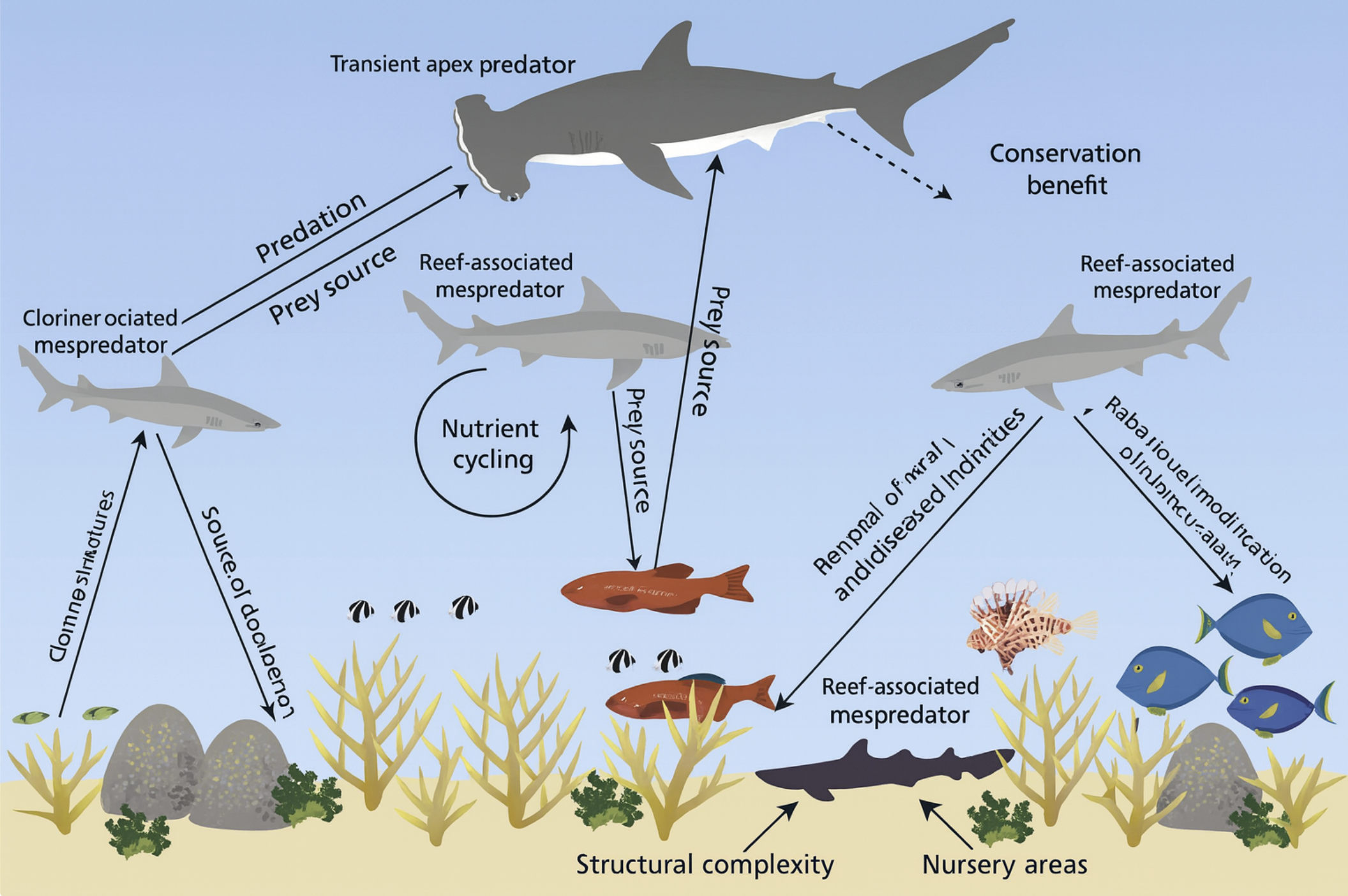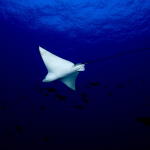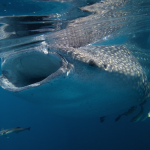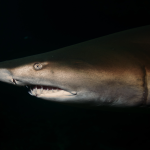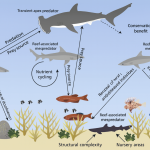With a focus on shark conservation in the region, the influence of sharks on the ecosystem of the Persian Gulf and Arabian Sea, and the role of the Gulf Elasmo Project in raising awareness.
More than fear, the vital role of sharks
When many people think of sharks, they picture dramatic scenes of dorsal fins cutting through the surface, big predators circling swimmers, or movie-style attacks. But in the shallow seas of the Arabian Sea and the Persian Gulf, sharks are not just dramatic – they are essential to the health, balance, and resilience of marine ecosystems.
At the same time, these regions are under intense pressure from development, fishing, habitat loss, and climate change – placing sharks (and related rays) at risk while the wider ecosystem loses a key stabilizing force. The Gulf Elasmo Project is working to document, protect, and restore awareness of this vital group. Here’s a deep dive into why sharks matter, what is happening to them in the region, and what we can do.
Sharks in the Arabian Sea / Persian Gulf region: the background
The waters of the northern Indian Ocean, including the Arabian Sea, the Persian (Arabian) Gulf, the Gulf of Oman, and adjacent shelves, host a surprisingly rich diversity of elasmobranchs (sharks, rays, and related fishes).
Key facts:
- The Persian Gulf is environmentally unique: shallow, warm, semi-enclosed, with intense coastal use and a long history of fishing.
- Stable isotope studies show that sharks and rays occupy a wide range of trophic levels, helping maintain ecological balance.
- Despite increasing research, data on many species remain limited, and several were only recently documented or have highly restricted populations.
- The region contributes a significant share of global shark and ray landings, which underscores the human pressure these species face.
This combination – biologically rich zone, heavy human use, incomplete data – makes the Gulf region a critical testing ground for shark conservation.

Why sharks are ecologically important
Trophic control and food-web stability
Sharks and large rays act as apex or meso-predators. They regulate prey populations and prevent chain reactions where the loss of predators leads to overgrowth or collapse of other species.
For example:
- Large sharks prey on mid-level fish, keeping them from depleting smaller benthic organisms.
- Rays and smaller sharks feed on invertebrates and crustaceans, influencing sediment health and nutrient cycles.
- By maintaining balanced prey populations, sharks support overall ecosystem stability.
Bioturbation, nutrient flow and habitat shaping
Many sharks and rays live close to the seabed. Their digging and foraging stir up sediments, oxygenate them, and redistribute nutrients. This “natural tilling” prevents sediment from becoming stagnant and supports healthy coral and seagrass systems – especially important in shallow, warm waters like the Gulf.
Connectivity and migration
Some shark species migrate between habitats – reefs, mangroves, seagrass beds, and open shelves. These journeys link different ecosystems, spreading nutrients and maintaining connectivity. When shark populations collapse, this flow of energy and genetic diversity breaks down.
Indicators of ecosystem health
Because sharks live long lives, mature slowly, and sit atop the food chain, their numbers reflect the health of marine ecosystems overall. Sharp declines often signal deeper issues: overfishing, pollution, or habitat loss. In the Gulf and Arabian Sea, shrinking shark populations are clear warnings.
What’s happening to sharks in the Arabian Sea / Persian Gulf region
Heavy fishing pressure and bycatch
Fishing fleets across the region catch sharks both intentionally (for fins, meat, and liver oil) and as bycatch in nets and trawls.
- Landings data show a steady drop in the number and size of sharks caught.
- Many species reproduce slowly – late maturity and few young – so even moderate fishing pressure can cause collapses.
- Shark-like rays (guitarfishes and wedgefishes) are among the most endangered, and the Gulf is one of their main hotspots.
Habitat degradation and coastal impacts
Sharks depend on mangroves, seagrass meadows, coral reefs, and sandy flats – but all of these habitats are under threat.
- Coastal development and land reclamation reduce nurseries and feeding grounds.
- Pollution and sedimentation smother corals and seagrass.
- Temperature extremes and salinity fluctuations add physiological stress.
Even where fishing is regulated, habitat destruction continues to erode shark populations indirectly.
Data deficiency and management gaps
For many regional species, we still lack basic data: population sizes, growth rates, and migration routes.
- Some species remain poorly described or misidentified.
- Management rules differ between countries and are not always enforced.
- Bycatch and trade are under-reported.
Without accurate data, regulation becomes guesswork – and sharks keep disappearing.
Trade and the fin market
Demand for shark fins and related products drives global exploitation, and the Arabian region is part of that network. Studies estimate that over ten percent of fins entering major markets may originate from the Arabian Sea and nearby waters. This trade adds major pressure beyond local consumption.
Rapid ecosystem shifts
When sharks vanish, the whole system shifts:
- Mid-level predators explode in number and overconsume small fish and invertebrates.
- Algae overgrow corals as herbivores decline.
- Fisheries catch composition changes, reducing both biodiversity and yield.
Such cascades are hard to reverse and can permanently alter the Gulf’s marine landscape.
The Persian Gulf: a case study
The Persian (or Arabian) Gulf is one of the harshest marine environments on Earth: shallow, saline, hot, and heavily industrialized. Yet it hosts unique shark and ray diversity, including several endemic species.
Recent surveys revealed:
- 300+ individuals of sharks and rays captured in hundreds of trawl samples – small numbers that highlight rarity.
- Greater diversity than previously known, suggesting some species go unnoticed in catch records.
- Fewer large individuals than in the past, confirming long-term overfishing.
For local economies, this decline matters. Sharks and rays help regulate prey fish, sustain coral health, and even attract ecotourism. Losing them undermines fisheries, biodiversity, and livelihoods. Protecting sharks here means protecting the Gulf’s natural resilience.
What the Gulf Elasmo Project is doing
The Gulf Elasmo Project works to close data and awareness gaps through:
- Field surveys documenting diversity, distribution, and population trends.
- Citizen science – involving divers, fishermen, and tourists in reporting sightings and bycatch.
- Education and outreach via public talks, school programs, and media.
- Advocacy for bycatch reduction, sustainable fisheries, and habitat protection.
By connecting science with communities, the project turns data into action and empowers people across the region to take part in shark conservation.
What you can do
Everyone can help safeguard sharks and rays in the region – no degree in marine biology required.
Report sightings
If you see a shark or ray while diving or fishing, record the date, location, depth, and behavior. Photos are invaluable for identifying species. Many organizations, including the Gulf Elasmo Project, collect such reports to map distributions.
Interact responsibly
- Keep a respectful distance; never chase or touch sharks or rays.
- Avoid flash photography in shallow water.
- On boats, slow down near reefs and seagrass beds where rays rest.
Support habitat conservation
- Advocate for mangrove and seagrass protection.
- Take part in local cleanup or restoration efforts.
- Reduce plastic use and coastal pollution.
Make informed choices
- Choose seafood from sustainable sources.
- Avoid buying shark products or souvenirs.
- Share facts, not fear – help change how people perceive sharks.
Key challenges and next steps
Data gaps
Many Gulf and Arabian Sea species remain poorly studied. Research must expand to include tagging, genetics, and long-term monitoring to understand migrations and reproduction.
Regional cooperation
The Gulf’s waters are shared by multiple countries with different laws. Coordinated management – standardized catch limits, protected zones, and trade controls – is essential.
Balancing livelihoods and protection
Coastal communities rely on fishing. Conservation must integrate economic alternatives, gear innovation, and fair enforcement rather than blanket bans.
Climate change
Warming, salinity shifts, and rising seas add stress to already fragile ecosystems. Conservation must anticipate these changes and build resilience.
Why it matters globally
While shark declines are a worldwide issue, the Arabian Sea and Persian Gulf are special.
- They represent a biodiversity hotspot in extreme conditions.
- Lessons learned here can guide conservation in other stressed regions.
- Protecting sharks in these waters supports global efforts to maintain healthy oceans.
What happens here resonates far beyond the region – because the Gulf’s ecosystems mirror the future challenges many coastal seas will face.
Conclusion
Sharks in the Arabian Sea and Persian Gulf are far more than symbols of fear. They are engineers of the seabed, regulators of food webs, and indicators of ocean health. Yet they face mounting threats from overfishing, habitat loss, and lack of coordinated management.
The Gulf Elasmo Project and similar initiatives show that change is possible – with better science, collaboration, and public engagement. Every diver, fisherman, policymaker, and citizen can be part of that change.
When sharks thrive, the entire ecosystem – from coral reefs to coastal economies – becomes stronger. Protecting them means protecting the future of the Arabian Sea itself.
Useful Links:
How to Participate in Gulf Elasmo Project Research
Rare Sharks and Rays of the Arabian
A Human’s Guide to Sharks of the Arabian Gulf
Publications

